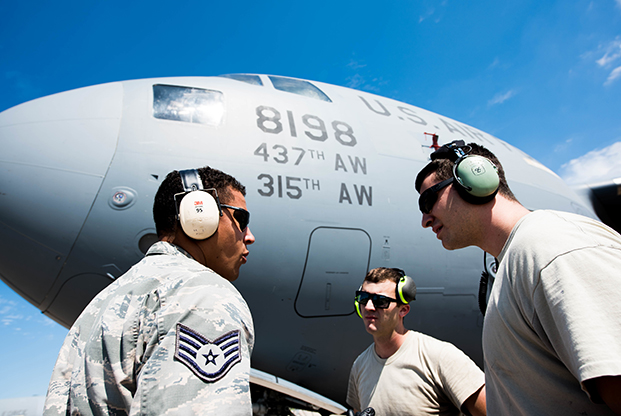
C-17s from Joint Base Charleston, S.C., that were evacuated to Scott AFB, Ill., ahead of the Hurricane Florence's arrival — like this one — were prepositioned for post-storm humanitarian response. Air Force photo by Staff Sgt. Michael Cossaboom.
Air Mobility Command’s Hurricane Florence response preparations started far before the storm came within beach-battering reach of North Carolina’s coastline.
“As the hurricane was developing, we needed to make sure that we protected our infrastructure, our assets, and our people,” Col. Jimmy Canlas, vice commander of the 618th Air Operations Center (Tanker Airlift Control Center) at Scott AFB, Ill., told Air Force Magazine in a Thursday phone interview.
Air Mobility Command takes a two-fold approach to storm preparation, Canlas said.
Part 1 is protection.
In Florence’s case, this meant moving aircraft and crews from Air Force installations in the Carolinas—like JB Charleston, S.C., and Seymour Johnson AFB, N.C.—to safer ground.
Charleston “basically had a scatter plan, if you wanna call it that, and moved the large majority of the assets … out of harm’s way and moved 10 airplanes over here to Scott Air Force Base,” he said, with six more planes being transferred to Wright-Patterson AFB, Ohio.
Seymour Johnson, on the other hand, evacuated fighter jets and KC-135s to Barksdale AFB, La., as Air Force Magazine reported Wednesday.
Part 2 is posture.
According to Canlas, last year’s meteorological triumvirate of hurricanes Harvey, Irma, and Maria showed AMC the value of employing evacuated aircraft and crews as an additional deployable disaster response. He noted that three “C-17s that evacuated from Charleston are over here on the ramp [at Scott] and they’re available for and postured to be able to respond to any emerging tasking.”
But the potentially deployable force is “much, much more” than those three C-17s and crews, Canlas said.
“We have to also think about the assets that are in the Air National Guard and … [the] Air Force Reserve,” he continued. “So, there’s a lot of volunteerism that’s out there.”
When it comes to actual storm response now that the hurricane has hit the US mainland, any such tasking will come from US Northern Command, via US Transportation Command. NORTHCOM Commander USAF Gen. Terrence O’Shaughnessy briefed reporters on storm-response readiness in a Thursday briefing at the Pentagon.
In the case of storms like Florence, Canlas said, the Federal Emergency Management Agency or the US Department of Health and Human Services are the civil authorities most likely to ask DOD for help.
While there’s no way to see the future when planning for storms, as of Thursday night, Canlas said, AMC was expecting storm surge and “the amount of rain on already saturated ground” to cause more damage than wind.
“With that said, … we’re thinking outside the box, … knowing that we might not be able to get directly close [to] … some of the airfields that we’d normally use in a devastated region,” he said. “ So, … we have to be looking at alternative methods of delivering aid.”
The roster of airfields that would actually be on deck for recovery efforts would depend on how much damage these USAF installations incur and whether flooding impedes runway access, Canlas said.
He pointed to Charleston during Hurricane Matthew as an example, noting that its airfield’s runway was submerged for “a good 14 hours” despite it being spared from any actual damage.
“It’s just a matter of … assessing the runway and making sure that it’s suitable for our aircraft, whether it be a C-17, a C-130, or a KC-135, or any of our mobility platforms, making sure that it’s good to go in,” he said.
But if Hurricane-Florence-induced damage skewed toward “the extreme side of the spectrum” like in post-earthquake Haiti, where toppled infrastructure made traditional landings impossible and necessitated airdrops of food and water, they’d still be equipped for the mission, he said.
“I think that’d probably be an extreme case, but if called upon, we’ll be able to still deliver if asked to do so,” Canlas said.
While the command’s capabilities for rapid mobility across the globe have made it a centerpiece of USAF’s readiness, its role in responding to domestic emergencies like Hurricane Florence is also a huge part of its mission.
“When we look at the whole range of military options, anything from the low-end side of the spectrum, which is humanitarian operations, all the way up into the high-end kinetic and, slash, contested operations, we operate everywhere in and along that spectrum line,” Canlas said.
At the end of the day, though, he said it’s all about balance.
“Definitely, Florence is near and dear to our hearts, but we are a global operations center, and so we have to balance the requirements here in the homeland together with other requirements that might be happening overseas,” Canlas said.
The existence of a mission-priority system “makes it a little easier to make that decision matrix,” but it’s up to combatant commanders to judge whether responding to a manmade threat will take precedence over responding to a natural disaster, he added.
Regardless of whether they’re put to work on the storm front or on a great-power battlefield, though, 618th AOC (TACC)’s superintendent CMSgt. Ernest Crider said, AMC airmen are “able, willing, and ready to support” whatever operations they’re tasked with.
“They’re going to stop at no end to get their job done,” he said.